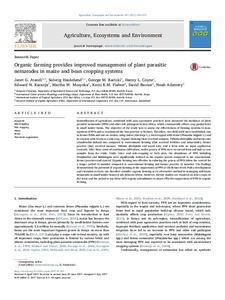| dc.contributor.author | Atandi, J.G. |
| dc.contributor.author | Haukeland, S. |
| dc.contributor.author | Kariuki, G.M. |
| dc.contributor.author | Coyne, D.L. |
| dc.contributor.author | Karanja, E.N. |
| dc.contributor.author | Musyoka, M.W. |
| dc.contributor.author | Fiaboe, K.K.M. |
| dc.contributor.author | Bautze, D. |
| dc.contributor.author | Adamtey, N. |
| dc.date.accessioned | 2019-12-04T11:09:08Z |
| dc.date.available | 2019-12-04T11:09:08Z |
| dc.date.issued | 2017-09 |
| dc.identifier.citation | Atandi, J.G., Haukeland, S., Kariuki, G.M., Coyne, D.L., Karanja, E.N., Musyoka, M.W., ... & Adamtey, N. (2017). Organic farming provides improved management of plant parasitic nematodes in maize and bean cropping systems. Agriculture, Ecosystems & Environment, 247, 265-272. |
| dc.identifier.issn | 0167-8809 |
| dc.identifier.uri | https://hdl.handle.net/20.500.12478/1983 |
| dc.description.abstract | Intensification of agriculture, combined with poor agronomic practices have increased the incidence of plant parasitic nematodes (PPN) and other soil pathogens in East Africa, which consequently affects crop productivity in small holder farms. The objective of the study was to assess the effectiveness of farming systems in management of PPN and to recommend the best practice to farmers. Therefore, two field trials were established, one in farmer fields and one on-station, using maize (Zea mays L.), intercropped with beans (Phaseolus vulgaris L.) and in rotation with beans as a sole crop. Organic farming (that received compost, Tithonia diversifolia and neem cake (Azadirachta indica)) was compared to conventional farming (that received fertilizer and nematicide), farmer practice (that received manure, Tithonia diversifolia and wood ash), and a farm with no input application (control). After three years of continuous cultivation, twelve genera of PPN were recovered from soil and/or root samples from the trials. Under inter- and sole-cropping at both sites, the abundance of PPN including Pratylenchus and Meloidogyne were significantly reduced in the organic system compared to the conventional, farmer practices and control. Organic farming was effective in reducing the genera of PPN below the control for a longer period (4 months) compared to conventional farming and farmer practice (2 months). The findings demonstrated the potential of organic farming in the suppression of PPN at the farmer level. Policy development and extension services can therefore consider organic farming as an alternative method in managing soil-borne nematodes in small holder farms in sub-Saharan Africa. However, further studies are required on other crops, in dry areas and the period to top-dress with organic amendments to assure effective suppression of PPN in organic farming. |
| dc.description.sponsorship | Swiss Agency for Development and Cooperation |
| dc.description.sponsorship | Liechtenstein Development Service |
| dc.description.sponsorship | Coop Sustainability Fund |
| dc.description.sponsorship | Biovision Foundation |
| dc.format.extent | 265-272 |
| dc.language.iso | en |
| dc.subject | Intercropping |
| dc.subject | Sole Cropping |
| dc.subject | Maize |
| dc.subject | Beans |
| dc.subject | Nematode |
| dc.subject | Cropping Systems |
| dc.subject | Farming Systems |
| dc.subject | Organic Farmimg |
| dc.subject | Agronomy |
| dc.subject | Smallholder Farmer |
| dc.title | Organic farming provides improved management of plant parasitic nematodes in maize and bean cropping systems |
| dc.type | Journal Article |
| dc.description.version | Peer Review |
| cg.contributor.crp | Integrated Systems for the Humid Tropics |
| cg.contributor.crp | Roots, Tubers and Bananas |
| cg.contributor.affiliation | Kenyatta University |
| cg.contributor.affiliation | International Centre of Insect Physiology and Ecology |
| cg.contributor.affiliation | International Institute of Tropical Agriculture |
| cg.contributor.affiliation | Research Institute of Organic Agriculture, Switzerland |
| cg.coverage.region | Africa |
| cg.coverage.region | East Africa |
| cg.coverage.country | Kenya |
| cg.isijournal | ISI Journal |
| cg.authorship.types | CGIAR and developing country institute |
| cg.iitasubject | Agronomy |
| cg.iitasubject | Farming Systems |
| cg.iitasubject | Maize |
| cg.journal | Agriculture, Ecosystems and Environment |
| cg.howpublished | Formally Published |
| cg.accessibilitystatus | Limited Access |
| local.dspaceid | 85539 |
| cg.targetaudience | Scientists |
| cg.identifier.doi | http://dx.doi.org/10.1016/j.agee.2017.07.002 |

